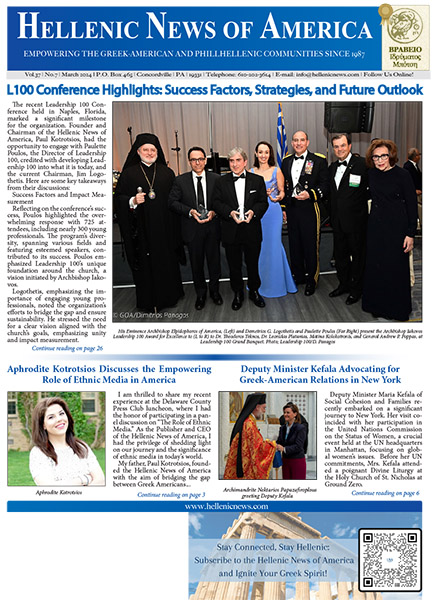By Catherine Tsounis
The Greeks of the Black Sea Coast have a deep sorrow. Their 2,500-year-old civilization was wiped out in 1922 in Modern Turkey. Refugees sought refuge in Russia, Greece and other areas. This is the Western perspective. I went to the Hermitage, in St. Petersburg, Russia and saw exhibits on the glory of the Black Sea coast Greek colonies that I did not see in any museum in Greece. The history of the Pontian Greeks is alive and well in the 2016 Hermitage Museum. One must question the demonization of a country that probably has one of the best collections of Byzantine and Ancient Greece civilizations. This country has a deep love for the basis of Western civilization that is being wiped out in the Middle East and Anatolia.
“Greeks who built cities in the Bosporus two and a half millennia ago settle there next to barbaric tribes, who had been living in the territory for ages and whose way of life was quite different. Their interaction resulted in a peculiar type of culture that took shape in the ancient cities and had a great impact on the style of local artists. Features of this symbiosis are preserved in many works of jewelry, particularly those discovered in the tombs of prosperous citizens and aristocracy of the Kingdom of Bosporus and burial mounds of tribe leaders who had adopted Greek tastes.
The antique jewelry held in the Hermitage, which date from the 6th century B.C. to 3rd century A.D. come from the northern shores of the Black Sea. Excavations in the region laid the foundation for Russian archeology. Objects unearthed in their course formed the basis of the Hermitage Archaeological collection.
Magnificent examples of jewelry include: jewelry imported from Hellas; masterpieces made by the talented carver Dexamenos, who was active in the Bosporus; items fashioned to imitate Greek originals; Scythian jewelry decorated in the Greek style and genuine works of local goldsmiths. In them we see the movement of their owner’s souls (their DNA), their aesthetic and religious attitude to the world around them as well as superstitions. Without them, the history of antique art would be incomplete.”1
A gold, sapphirine scaraboid or impression seal to legalize documents is from around 575 B.C. from the Bosporus. It shows a heron in flight, that symbolized a good omen. Dexamenos of Chios created the seal. It is a beautiful blue stone that has survived time. 2 The gold lions’ heads of two silver bracelets show amazing detail. They were created in late 5th to early 4th century B.C. They represent one of the finest examples of classical jewelry, from the Pantikapaion necropolis, a Greek colony in the Eastern Crimea.3
The Hermitage complex consists of five historic interconnected buildings, the largest and most impressive of which is the Winter Palace, which alone contains over 1,000 rooms, 1,700 doors, 1,900 windows, and 100 staircases. This vast palace, an imposing symbol of imperial might and prestige, was the official residence of the Romanov Tsars from 1762 until the revolution in 1917.34

We passed through the Hall of Twenty Columns with its mosaic floor and collection of Italian vases, to see the gigantic Kolyvan vase. It weighs 19 tons. The floor of the Athena Room is decorated with an authentic 4th-century mosaic excavated in an early Christian basilica in Chersonesos (modern Crimea) in 1854.
The collection of Classical Antiquities featured: Greek artifacts from the 3rd millennium – 5th century BC, Ancient Greek pottery, items from the Greek cities of the North Pontic Greek colonies, Hellenistic sculpture and jewelry, including engraved gems and cameos, such as the famous Gonzaga Cameo, Italic art from the 9th to 2nd century BC, Roman marble and bronze sculpture and applied art from the 1st century BC – 4th century AD, including copies of Classical and Hellenistic Greek sculptures.
The Hermitage Museum in St Petersburg has one of the world’s great collections of Greek vases. In addition to the numerous vases and fragments found on Russian territory, it includes those found in Italy and acquired directly or purchased from other collectors, most notably the Marquis Campana, Antonio Giuseppe Pizzati and Countess Lava. I was amazed by the size and excellent condition of the Greek vases. While much of the classical collection represents the collecting mania of Catherine and her successors, the halls devoted to artifacts from the North Black Sea Coast are a testament to the more serious work of 19th and 20th Century Russian/Soviet archaeologists, and are fascinating for the picture they give of this outpost of ancient civilization, where Greek and Roman influences mixed with local barbarian and Scythian traditions. The collection covers the period from the 6th century BC to the 4th century AD.
The fact that we can see Classic and Black Sea coast treasures is extraordinary. The Unesco 1 century A.D. site of Roman Palmyra temple was destroyed in August 2015, when ISIS gained control of Syria.6 Greeks from the Black Sea coast can travel to the Hermitage to renew their roots. Russia has been through social, political upheaval and a Nazi invasion. They rebuilt their palaces and monuments, preserved their classical treasures so the global community can enjoy them.
References:
- Kalashnik, Yuri, “Greek Gold” In the Hermitage Collection. The State Hermitage Publishers, 2014, St. Petersburg, 2014, preface.
- Kalashnik, Yuri, pp. 88-89.
- Kalashnik, Yuri, pp. 80-81.
- https://www.saint-petersburg.com/tours/walking-tours/hermitage-walking-tour/
- https://www.liquisearch.com/hermitage_museum/collections/classical_antiquities
- 6. https://www.worldpoliticsreview.com/trend-lines/16578/the-islamic-state-is-destroying-more-than-syrias-past-in-palmyra
Links:
https://commons.wikimedia.org/wiki/Category:Ancient_Greek_pottery_in_the_Hermitage_Museum -Oversize pottery-https://picasaweb.google.com/105743188183721570894/HermitageRussia – photo album
Photo 9 – A gold, sapphirine scaraboid or impression seal to legalize documents is from around 575 B.C
Links
Photo 10 – 5th century gold lions’ heads of two silver bracelets







